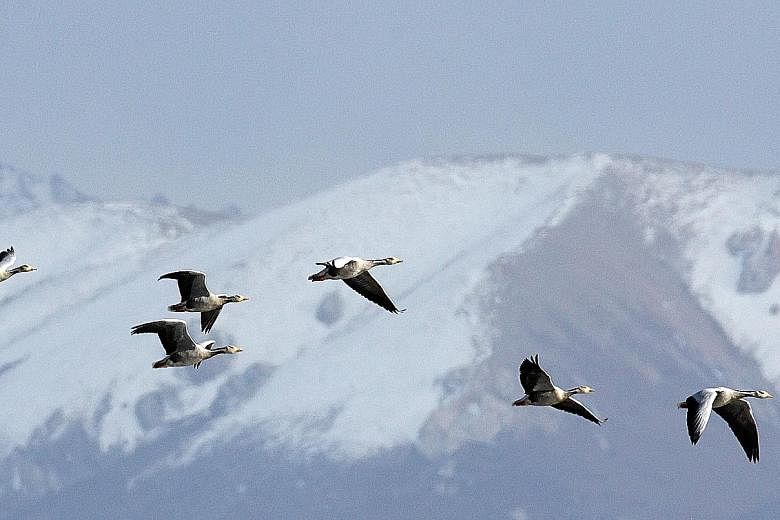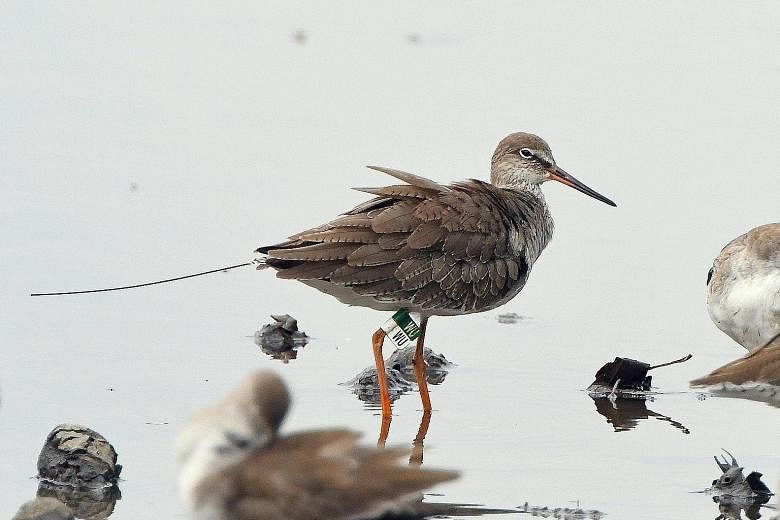Those familiar with migratory birds in Singapore would probably have heard of the Sungei Buloh Wetland Reserve.
Nestled in the country's north-west, the mudflats of the reserve serve as a buffet spread for flocks of migratory birds, especially shorebirds - a diverse group of birds best associated with coastal wetlands.
Indeed, these travellers throng the coastal flats in Sungei Buloh and offshore Pulau Ubin each year during the northern hemisphere's winter months.
Two of the most frequently seen birds are the lanky common redshank (Tringa totanus), named for its bright red legs, and the whimbrel (Numenius phaeopus), a large, striking shorebird with a distinct curved bill. Both are often seen here from late July, when they arrive from farther north.
Bird migration is a phenomenon that has been observed for millennia. But many questions remain.
How do these birds travel thousands of kilometres to reach Singapore? How do they return each year? What routes do they take?
AIR TRAVEL
A study led by researchers at the National Parks Board (NParks) threw up surprises last month.
By attaching devices to track the movements of common redshanks and whimbrels, they found that these common visitors to Singapore had travelled across the Himalayan mountain range before arriving here.
The journeys show that species in Singapore and more widely along the Malay Peninsula are also connected with the less studied migratory routes of the Central Asian Flyway (CAF).
Previously, many of the shorebirds that reach Singapore were presumed to have come via the better-known East Asian-Australasian Flyway (EAAF).
Flyways are like highways in the sky - many species take these broad set of migratory routes when they head from breeding grounds in the north to feeding areas in the tropics. There are about eight flyways in the world.
In the latest study, the researchers found that every common redshank tracked migrated north in spring towards the cold uplands of the Tibetan Plateau.
To undertake such a physically daunting journey, the redshanks, each weighing less than half an average coffee mug, must gain altitude rapidly to negotiate the lofty peaks of the Himalayas or the mountains on the eastern flank of Tibet. These migrations involve travelling up to 5,000km each way and gaining considerable elevation of well over 4,000m before arriving at their breeding areas on the plateau's wetlands.
One of the whimbrels studied flew across the Himalayas and the Tibetan plateau on its journey towards the sub-Arctic tundra on the north-west fringe of the Central Siberian plateau, while the rest of the birds flew along the coast of East Asia towards the Yellow Sea before heading north into Siberia.
Migratory birds travelling along the CAF traverse significant ecological-geographical barriers and boundaries, including crossing the world's highest mountains.
These birds fly over or go to the Taiga-Tundra ecosystems of Siberia, the Gobi Desert, the Tibetan Plateau and the formidable mountains of Central Asia and the Himalayas before reaching their winter destinations on the rich lowlands of the Indian subcontinent.
We now know that some of these birds also move beyond the subcontinent before streaming into our part of the world, and in the process have to negotiate the highest mountain ranges on the planet.
The EAAF, however, presents less of a physical challenge. Most migratory birds using this route typically move along the coastal lowlands of East Asia during the autumn, before funnelling through South-east Asia, and onwards to Australia and New Zealand.
These discoveries challenge the current thinking on the large-scale ecology of migratory birds in Asia, but also remind us how little we know about the biology of these birds, many which are now in danger of extinction due to threats like habitat loss and hunting.
The hope is that the use of technology in the study of migratory birds will continue to yield similarly exciting insights that can guide conservation efforts targeting these globetrotting species.
Satellite tracking devices are widely used by researchers for studying animal movements, and they send regular signals to a satellite in low orbit, allowing the specific locations of an animal to be monitored in real time.
Careful attachments of these devices on the birds' back (often like a backpack) allow scientists to remotely track and observe their movements.
These devices are tiny - they weigh less than 3 per cent of the bird's weight - and do not influence its natural behaviour.
Researchers also use light-level geolocators. These tiny devices are cheaper than satellite tags and weigh less, as little as a third of a gram, and are increasingly being used by scientists to study the migration of smaller birds.
However, unlike satellite tags that can transmit data from afar, the use of geolocators requires researchers to recapture the animal to retrieve data.
FEATHERED AMBASSADORS
Compared to the charismatic rainforest species of South-east Asia, migratory birds may not always be the most familiar group of wildlife.
Many species are small, dull-coloured and not particularly conspicuous. Even scientists and seasoned bird watchers have a hard time finding or identifying them.
But these feathered travellers show us how interconnected the planet is.
Ecological connectivity is an important concept in conservation strategies and is defined by the United Nations as the degree to which landscapes and seascapes allow species to move freely, while ensuring ecological processes can continue to function unimpeded.
The maintenance of ecological connectivity is critical in combating the decline of biodiversity while ensuring that nature continues to deliver benefits for people in the form of ecosystem services.
Migratory bird species are essentially flagships of "ecological connectivity" because they link the different ecosystems they live in, and literally drive the movement of nutrients and other biological matter across large distances, while playing definite ecological roles in the very ecosystems they live in.
The life cycles of birds such as the whimbrel and common redshank effectively connect the high tundra they breed in with the various inland and coastal wetlands they stop over at in their migratory journeys across vast distances in the Asia-Pacific region.
In essence, migratory birds give a recognisable "face" to the ecosystems they are associated with at very large spatial scales, especially coastal wetlands which are in rapid decline all over the world.
Migratory birds also provide opportunities to stimulate cooperation across nations.
Fortunately, migratory birds in general, and shorebirds in particular, are gaining more local and global profiling, thanks largely to the efforts of conservationists, researchers and governments.
Less than a year ago, Myanmar announced its plan to expand the Gulf of Mottama wetlands as a "Wetland of International Importance" under the Ramsar Convention in its bid to better protect waterbird habitats, and the highly endangered spoon-billed sandpiper.
India has launched its first national action plan for the CAF, focused on protecting more than 40 wetlands for migratory birds, and commencing work on single species' action plans.
The first secretariat to coordinate conservation activities for migratory birds in the CAF will also be established in India.
Similarly, concerted conservation efforts are under way in many South-east Asian countries. The Bird Conservation Society of Thailand acquired an area of wetlands along the Inner Gulf of Thailand early last year for use as a private nature reserve for migratory birds.
THE ROLE OF THE LITTLE RED DOT
In Singapore, the Government recently announced plans to expand the Sungei Buloh Wetland Reserve to cover an extensive section of the northern coastline, effectively putting more areas of critically important migratory shorebird habitats and carbon-rich wetlands under conservation management.
Emerging knowledge from studies such as the latest one by NParks, as well as data from generations of citizen scientists and bird ringers, shows that Singapore and the Malay Peninsula sit along important migratory routes connecting both the East Asian and Central Asian flyways.
More than 100 species of migratory birds come here every year. Many stop by the forests and wetlands to refuel and recharge before continuing their journeys to Indonesia and Australia.
Shorebirds such as the common redshank and whimbrel are among the most familiar of the migratory species here.
Less familiar are the large numbers of birds of prey such as honey buzzards and sparrowhawks, as well as little songbirds such as the Asian brown flycatcher, Arctic warbler and Siberian blue robin.
The appearance of striking migratory species such as pittas, kingfishers and flycatchers in the urban sprawl, many severely injured or killed by collisions with glass windows, is becoming a morbid way for the public to learn about bird migration, as is the case for other big cities in Asia.
Research such as the work led by NParks colleagues to understand the ecology and journeys of migratory birds is timely and adds a critical piece to the wider jigsaw of the place of Singapore's ecosystems in the context of Asia.
Perhaps a more important take-away from studying migratory birds is the constant reminder that conserving biodiversity, in this case migratory species shared between countries, can benefit not only from local efforts but also through global cooperation.
Few groups of wildlife bring this out as strongly as migratory birds.
-
About the authors
-
Dr Yong Ding Li is flyways and policy manager at BirdLife International's Asia division and is based in Singapore. Mr Sayam U. Chowdhury is a PhD candidate at the University of Cambridge, the assistant coordinator of the spoon-billed sandpiper task force, and is based in Dhaka, Bangladesh. Ms Neha Sinha is conservation and policy officer at the Bombay Natural History Society, a partner of BirdLife International in India, and is based in Mumbai.


